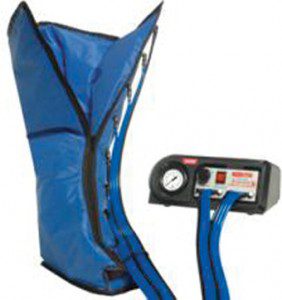By Alyssa Parker –


Chronic venous insufficiency is another condition that causes swelling in the legs along with open wounds. CVI occurs when the valves in the veins that normally channel the blood to the heart become damaged which then leads to pooling of the blood in the lower extremities. Sometimes a discoloration of the skin occurrs, referred to as hemosiderin staining, identified by a reddish staining of the lower limb. At times poor circulation results in shallow wounds due to the stagnant blood that would normally return to the heart. Symptoms vary but may include swelling, aching, sharp pains, itching or burning, varicose veins, infection, chronic venous ulcer, and decreased mobility.
Treatment
Pneumatic compression devices are one of the most highly recommended treatments for limb swelling and are a Medicare approved treatment option. A compression device is used for both acute care (short term in the hospital) as well as chronic care (long term in the home). The compression pump increases blood flow and lymphatic flow. By increasing the circulation in the affected limb, many painful symptoms will be alleviated. When compression treatment is used on a limb, the excess fluid is removed and worked back into the lymphatic system the natural way. For patients with chronic ulcers, using a compression device will help heal the wound from the inside out by increasing the circulation in the return of the blood from the heart.
The heart delivers oxygen rich blood back to the legs and the tissue. The pneumatic sequential compression relieves the pain and pressure in the swollen area and reduces the size of the limb. The sequential inflation of the chambers, of the sleeve around the affected limb, begins distal (lower region of the limb furthest from attachment) to proximal (area of attachment to the body) naturally mimicking your bodies lymph return while stimulating the blood flow in the legs.
For more infromation, you can speak with an expert at Acute Wound Care today by calling 239-949-4412. Or visit us on the web at www.AcuteWoundCare.com .
 Southwest Florida's Health and Wellness Magazine Health and Wellness Articles
Southwest Florida's Health and Wellness Magazine Health and Wellness Articles

